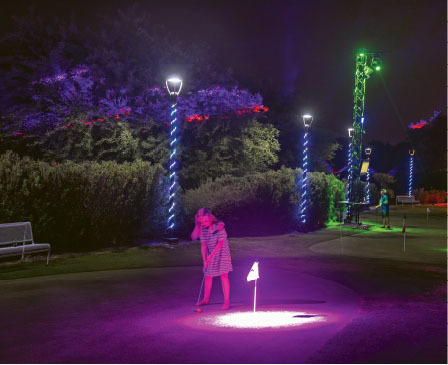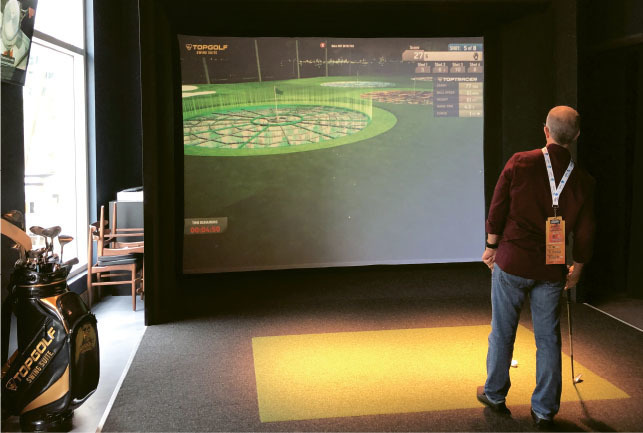The April 29, 2019 issue of Travel Weekly speaks to how resorts have evolved their golf offerings to appeal to a broader audience, with SLRG’s Jon Last offering contextual perspective.
by Christina Jelski
While countless media reports over the past decade have proclaimed golf a dying sport, golf resorts that have put a more creative spin on driving business are seeing evidence to the contrary.
“Golf, like really everything else in society these days, is evolving,” said Steve Mona, executive director for the trade coalition We Are Golf. He estimated that a record 2.6 million people became first-time golfers in the past year.
“Golf used to mean 8 a.m. on a Saturday morning on the first tee at a private club, wearing khaki pants, a golf shirt and a visor [and shoes] with metal spikes,” Mona said.
“And now, it can mean 8 p.m. on a Saturday night, with a hat on backward, shirt untucked, wearing cargo shorts and flip-flops at a Topgolf.”
Indeed, the breakout success of Topgolf’s golf-centric gaming and entertainment venues has been credited with helping to spawn a sudden surge in interest in the sport.
The Topgolf brand, which was founded in 2000 in the U.K. and now has 53 locations across the U.S., combines climatecontrolled hitting bays, high-tech simulators and other activities with premium food and beverage and an upscale, lounge-like atmosphere.
Topgolf-branded simulator bays have even started popping up at urban properties and casino-hotels across the country. The Silver Resort Casino in downtown Reno, Nev., opened a Topgolf Swing Suite this month, and the Tampa Marriott Waterside Hotel & Marina added a Topgolf Swing Suite as part of a recent refresh of its Garrison Tavern restaurant and bar.

Many top courses remain rigidly button-down, requiring players to dress in long pants and collared shirts that must be tucked in. But in an effort to tap into the fast-growing Top golf trend and attract a wider demographic, some golf resorts are borrowing from the concept’s more social, laid-back approach.
At the Indian Wells Golf Resort in Indian Wells, Calif., near Palm Desert, an after-dark Shots in the Night program offers a unique option for guests seeking a more relaxed and communal golf experience. Shots in the Night showcases two offerings — the Glow Golf Range and the Putting Experience — that can be played for $40 an hour per group of up to six.
The Glow Golf Range comprises 12 practice range stalls and giant, blow-up targets, while the Putting Experience uses laser projections to turn seven putting greens into activity areas with games inspired by beer pong, shuffleboard and corn hole, among others. The program, which is offered every Thursday through Saturday, also incorporates a DJ, a bar and a food truck.
“It’s something that’s accessible and fun and doesn’t really take too much skill,” said Michael Tebbetts, director of sales and marketing for Indian Wells Golf Resort. He said Shots in the Night has been a hit, particularly among corporate groups.
“Around 75% of the people who come for Shots in the Night have never played golf,” Tebbetts said.
Likewise, Perry Cabin Resorts & Golf in St. Michaels, Md., has opted to complement its Pete and Alice Dye-designed course with eight state-of-the-art simulators, which can be used for lessons or rented out for fun or practice. The simulators offer immediate feedback and swing analysis, attracting both beginners and experts looking to improve their game.
Even bucket-list golf destinations such as North Carolina’s Pinehurst Resort have sought to add more accessible golf experiences to the mix. In 2017, the property debuted the Cradle, a nine-hole course that takes about 45 minutes to complete and has a green fee of $50. Kids 17 and younger can play the course for free with a paying adult.
The Cradle also features a beverage stand with outdoor seating, where both golfers and non golfers are encouraged to relax and mingle.
Pinehurst Resort executive vice president Matt Massei, said, “If you heard that golf was too expensive or that it takes too long, the Cradle really nullifies those two factors for you.”
Massei added that Pinehurst’s 18-hole putting course, Thistle Dhu, is also popular with newer players.
Pinehurst upped its millennial cachet with the opening of its craft brewery late last year. Housed within a former steam plant building, Pinehurst Brewing Co. serves a variety of draft beers as well as local smokehouse favorites like pulled pork, beef brisket and ribs, offering a departure from typical clubhouse fare.

Other resorts, such as the Westin Kierland Golf Club in Scottsdale, Ariz., have lured players with a diverse array of golf cart alternatives. The property has already successfully integrated Segways, Golf-Board electric skateboards, Golf Bikes and Kierland Turf Rider scooters, and it plans to add a fifth, yet-to-be-announced mode of transport soon.
Palmetto Dunes, a golf and beach resort on South Carolina’s Hilton Head Island, has also introduced Golf Bikes as well as larger, four-person carts, complete with USB ports and GPS, which have proven popular among millennial players.
Further adding to the property’s appeal is the availability of free clinics on Mondays and a Quick Six summer family program, which features a six-hole game that’s priced at $29 for adults, $15 for kids ages 10 to 17 and free for kids under 10. The fees include carts and rental equipment.
Green fees have long fluctuated with the time of day, but for those playing a traditional round, Palmetto Dunes has expanded the dynamic pricing, offering guests as much as 50% off in the afternoon.
Miami’s Biltmore Hotel, which unveiled a newly restored Donald Ross course in December, has debuted similar dynamic pricing as well as daily free golf clinics for guests and other golf education programming.
“We provide the opportunity for people to find a price that fits their budget,” said Bob Coman, director of golf at the Biltmore Hotel. “[It] depends on what time you play, if it’s a weekday or weekend, and whether it is winter or summer season. If you are flexible, you can play nine holes at the Biltmore for an evening twilight rate of just $59 to $66, inclusive of greens and cart fees.”
Golf’s ongoing transformation comes as industry insiders claim that the recent hand-wringing over the sport’s alleged demise is much ado about nothing.
The latest estimates of current U.S. participation rates have stabilized at just over 24 million people, and Jon Last, president of the Sports & Leisure Research Group, said the rumored drop-off in activity doesn’t really jibe with the facts.
Citing research undertaken by the National Golf Foundation, Last said, “A lot of these media claims are very subjective in the time frame they choose to reference. Yes, the number of golf participants hit a high of around 30 million about 13 years ago. But that period was also a market bubble,” which resulted from a number of contributing factors.
“We had a booming economy, and you had Tiger Woods mania at its absolute peak,” he said. “Obviously, once the economy cooled, we regressed, and people said the sky is falling. But if you go back 25 years ago or so, the number of participants was substantially lower than now.”
With Woods recently staging a career comeback and celebrating his fifth Masters win in mid-April, Last added that he “would certainly not be surprised” to see participation in the sport spike again.
“In many ways,” he said, “the industry’s infrastructure is somewhat better prepared for resurgent interest than it was during Woods’ initial period of dominance, [and this year’s Masters] adds a fresh chapter for a new generation that can now follow Tiger’s reinvigorated quest to shatter a number of all-time records.”
